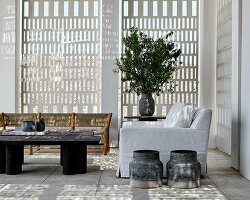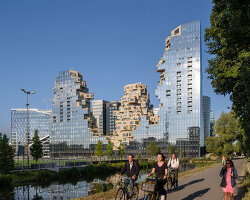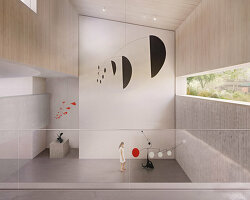the work of garden designer piet oudolf and landscape architecture firm LOLA is documented as part of a new book and exhibition, which is set to open in the netherlands.
over the past decades, oudolf has completed a wide range of projects, earning a reputation as one of the world’s most influential garden designers. after starting his landscape and garden design practice in 1976, alongside his wife anja, oudolf moved to hummelo — a village in the eastern part of the netherlands. it was here, in 1982, that the oudolfs started a nursery growing unusual, but garden-worthy perennials. following increased attention for his personal garden, oudolf began attracting international interest. now, 45 years after piet oudolf originally began his practice, the dutch garden designer has completed projects that include the high line in new york and the 2011 serpentine pavilion.

hummelo is the private garden of piet and anja oudolf | image courtesy of piet oudolf (also main image)
founded in 2006 by eric-jan pleijster, cees van der veeken, and peter veenstra, LOLA landscape architects couldn’t help but be influenced and inspired by oudolf. ‘when we were studying landscape architecture, ‘gardening’ was a swear word,’ peter veenstra tells designboom. ‘it meant someone had spent time on random details and shapes while losing track of the bigger picture. when slowly the interest in public gardens and more sophisticated planting plans was reemerging, piet oudolf was there to wow everyone with pictures of his gardens, including us.’ this interest has led LOLA to collaborate with oudolf on numerous occasions, including on this project in sweden with herzog & de meuron.

designed by oudolf, lurie garden is located in chicago’s millennium park | image courtesy of piet oudolf
the work of both oudolf and LOLA is presented in a new exhibition, which opens at the SCHUNCK museum in the netherlands on june 9, 2021. titled ‘in search of sharawadgi’, the display will take visitors on a journey, showing how public gardens and landscapes across the world have been transformed. in the context of landscape architecture, the term ‘sharawadgi’ — a corruption of the japanese sorowaji, meaning non-regular — has become synonymous with a style of landscape design or architecture that avoids rigid lines and symmetry to make the landscape appear organic and naturalistic. as LOLA and oudolf find themselves united in this endeavor, the term sharawadgi became the exhibition’s title and its central theme. documenting the projects in question, the presentation is accompanied by a 192-page book published in collaboration with nai010.

designed by oudolf, lurie garden is located in chicago’s millennium park | image courtesy of piet oudolf
to learn more about the creative approach of the designers, designboom spoke with piet oudolf and LOLA co-founder peter veenstra who discussed the renewed appreciation for outdoor space and how landscape architecture can help with issues such as rapid urbanization, climate change, and flooding. read both interviews in full below.
designboom (DB): you have designed gardens in a range of different environments. is your general approach the same when designing for the high line, compared to a private garden?
piet oudolf (PO): the approach is different. when designing a private garden I focus on the wishes and needs of an individual or family. you can decide together on the garden design based on their terms. in public space, one has to deal with so much more. not only more people, but also more restrictions, rules and regulations on accessibility and security and maintenance.

piet oudolf working on one of his designs | film still courtesy of thomas piper
DB: how do you want people to feel after spending time in one of your gardens?
PO: people who visit my gardens often come into contact with greenery of a higher amenity value than the general green of a regular park. it can also encourage interest in plants for people without a garden.

piet oudolf’s garden design for hauser & wirth | image courtesy of piet oudolf
DB: do you think there has been a renewed appreciation for outdoor space and gardening given the difficulties of the past year?
PO: in the past couple years, there has been an increase in the appreciation and growing interest in public green. remarkable is that a younger generation, people between 25 and 45 are the biggest group who has interest in gardens and greenery.

vlinderhof is a botanical garden piet oudolf designed in utrecht
interview continues with peter veenstra, co-founder of LOLA landscape architects, below.

image courtesy of hans van horssen
designboom (DB): this new exhibition is called ‘in search of sharawadgi’. what does this term mean to you, and how does it relate to your work?
peter veenstra (PV): the literal word sharawadgi is gibberish and doesn’t mean anything. it was the best recollection that sir william temple had of an eastern term to describe the natural, wild qualities of a garden. he brought it to europe and sparked the start of the english landscape style with it.
the word represents the desire of adding a sense of wilderness into our living environment, and is a first attempt to help to define and design it. much later, the word was adopted in music theory, and was described as ‘the sublime of the everyday’. I found that very inspiring for the practice of landscape architecture, as a goal — landscape design as a form of micro-dosing the grand sublime. much more calm and everyday, still contributing to well-being not only physically, but also in a reflective or spiritual way.
DB: this exhibition features your projects alongside those of piet oudolf. how much of an influence has oudolf’s work had on you?
PV: when we were studying landscape architecture, ‘gardening’ was a swear word. it meant someone had spent time on random details and shapes while losing track of the bigger picture. when slowly the interest in public gardens and more sophisticated planting plans was reemerging, piet oudolf was there to wow everyone with pictures of his gardens, including us.
our interest in piet’s work primarily led to collaborations, in which we both have our territory of expertise. in these collaborations, piet has inspired us: his absolute focus on the core of his work, openness to collaboration and positive world view.

rendering of the etzenrade castle project, designed by both LOLA and piet oudolf
PV (continued): in landscape architecture it can be hard to find inspiring clients, since most of them are either civil servants who are just doing their job, or project developers who’s heart is more attached to architecture. while we are building a reputation, this is improving, but piet is on another level. he attracts clients with a clear ambition when it comes to landscape, and an outspoken taste. that’s very stimulating to work with.
recently we got very interested in (re-)afforestation as a climate solution. while many of the large scale afforestation projects are rather monotonous, we asked ourselves: can we somehow bring some of the aesthetics that piet oudolf is bringing to his meadows, into forests? we started to develop algorithms to generate tree patterns with more natural diversity and surprise.

‘after landscape’ is a project by artist sanne vaassen in etzenrade | image by anne buscher
DB: the name LOLA comes from ‘LOst LAndscapes’. how important is it to ensure that good landscape architecture can be accessed by as many people as possible?
PV: on a global scale, there is no lack of beautiful nature. yet many people have a different daily experience, and we know how important it is for everyone’s well-being. you could say this is a problem of distribution and accessibility of nature. the core business of a landscape architect is to tune this accessibility and distribution. surely not all landscapes should be made accessible in the same way and become paved paradises like in joni mitchell’s song. you shouldn’t measure the success of a landscape or a public space by the amount of visitors. it’s a matter of finding the right balance between universal accessibility and universal inaccessibility — and everything in between.

‘after landscape’ is a project by artist sanne vaassen in etzenrade | image by anne buscher
DB: how can good landscape architecture help with issues such as rapid urbanization, climate change, and flooding?
PV: by envisioning future-proof environments that also offer a new perspective on how we can live together. the debate on spatial planning is very much focused on problems and solutions. but it’s important to go beyond solving problems — nobody wants to live in the solution of a problem. we need to create environments that inspire future generations.
it’s important to realize that most design research can fuel a discussion, but will never be realized. therefore it can help to make polemic plans — the biggest impact we ever had with design research was a scenario for the netherlands in 2200, where half the country is flooded. the radicality of the proposal sparked a widespread discussion on the long term future of the netherlands.

park groot vijversburg is a public park in the north of the netherlands designed by LOLA
DB: why do you think the netherlands has such a tradition of renowned landscape architects? are the country’s topography or climate factors?
PV: in the netherlands, all the necessary infrastructure is there for talent to grow; schools, clients, open-minded architects to collaborate with, funds, magazines. worldwide, landscape architecture is still an emerging profession; there are still many countries that lack a good school for landscape architecture.

the solana ulcinj masterplan proposed for montenegro | image courtesy of LOLA
PV (continued): the dutch landscape is a big playground for landscape architects. for a large part, the country is an artificial construction; everything has been designed, there is hardly any wilderness, and most of the historical landscapes have been rationalized into modern farmland. it’s not a natural beauty, and it is in constant need of surgery to keep it well. that generates a lot of work, but also a culture of innovation.
but to put things into perspective: the fact that dutch landscape architecture is well-known, is not just because of the quality. because we live in a small country, we are eager to export. we have a tradition of trade. the whole world knows heineken, and this is not necessarily because of the great taste of it.
book details:
name: landscape works with piet oudolf and LOLA — in search of sharawadgi
ISBN 978-94-6208-630-2 | june 2021 | expected | fabian de kloe, peter veenstra, joep vossebeld | design: sam jacob & fraser muggeridge | english | 21 x 30 cm | 192 pages | illustrated (200 full color) | in conjunction with: SCHUNCK museum, IBA parkstad
exhibition details:
name: landscape works with piet oudolf and LOLA — in search of sharawadgi
location: SCHUNCK museum, heerlen, the netherlands
dates: june 9 – october 17, 2021
architecture in the netherlands (365)
architecture interviews (272)
landscape architecture and design (85)
LOLA landscape architects (7)
piet oudolf (12)
PRODUCT LIBRARY
a diverse digital database that acts as a valuable guide in gaining insight and information about a product directly from the manufacturer, and serves as a rich reference point in developing a project or scheme.





























